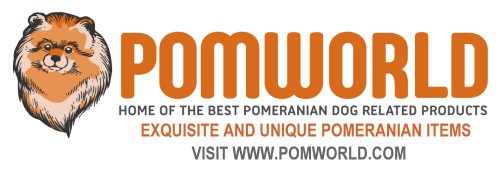Last Updated on 15/11/2022 by Dochlaggie. Post first published on November 15, 2022.
This article will explain in detail the German Spitz vs Pomeranian. The German Spitz breed and the Pomeranian share the same ancestry. Pomeranians were larger dogs in the early days and were used for hunting, herding, and almost everything else their owners required of them.
The Pomeranian and German Spitz are two different breeds that can be often confused with one another. However, there is a difference between these dogs in many ways including size and coloring patterns with the Pom being a smaller-sized, round, ball-shaped dog.
The German Spitz is classed as a separate breed in most countries. Because the two breeds are very closely related, they’re similar in many ways, and comparing their sizes, colors and physical characteristics helps you better appreciate the ways in which they do differ.
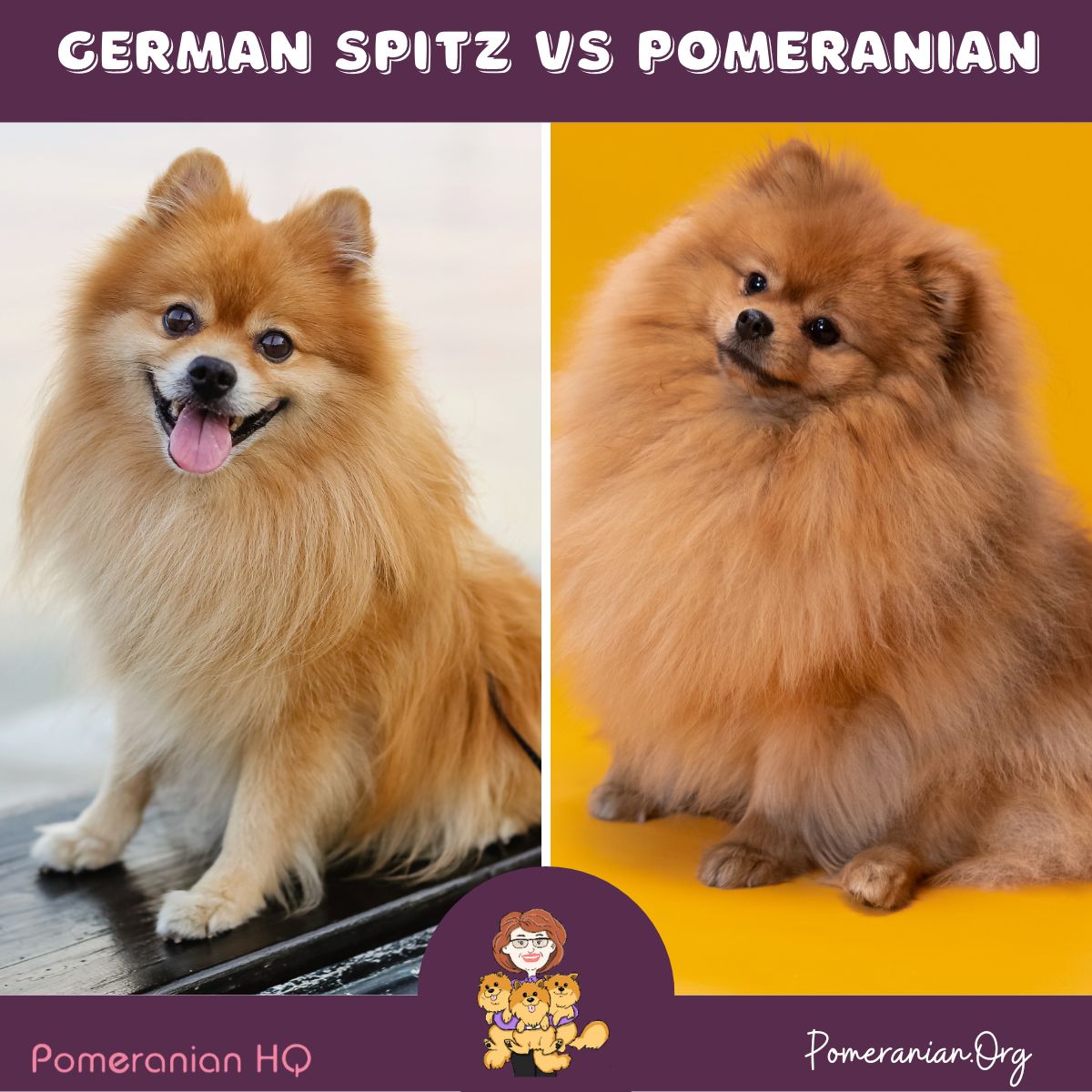
German Spitz vs Pomeranian Breed Comparison
Pomeranian | German Spitz |
Average Height 8 – 11 inches (18 – 24 cms) | Average Height 12-15 inches |
Weight Range 3 to 7 pounds (1.36 to 3.175kgs) | Weight Range 24-26 pounds |
Temperament Extroverted & intelligent | Temperament Attentive & easy to train |
Exercise Requirements Low | Exercise Requirements Moderate |
Grooming Requirements Moderate | Grooming Requirements Moderate |
Price Range $1000+ | Price Range $600+ |
AKC Breed Popularity Ranks 23 of 197 | AKC Breed Popularity Unknown |
Health Average | Health Average |
Purpose Companion dogs | Purpose Companion dogs |
Life Expectancy 12 to 16 years | Life Expectancy 13 to 15 years |
Pomeranians
Both dog breeds originated in Germany but the Pomeranian, as a breed, was developed in the United Kingdom. Pomeranians are smaller today than 100 years ago and are classified as a toy dog breed because of their small size.
The Pom is a short-backed, compact toy dog who thrives on being active. His double coat comprises a harsh-textured, profuse, long outer coat and a dense short undercoat.
A breed characteristic of the Pomeranian is the heavily plumed, high-set tail. The Pomeranian is the only spitz-type dog whose tail should lie flat and straight up his back.
The Pom is inquisitive, alert, intelligent, and expressive. He’s sound in action and composition and is buoyant in the way he carries himself.
The Pomeranian is animated, commanding, and cocky in nature. An average Pomeranian weighs 2 – 3 kgs but if you wish to show your Pom, his weight should be 1.8 – 2.2 kgs.
The FCI Toy Spitz ( Pomeranian) standard stipulates a height requirement of 20 cm at his withers.
Pomeranians come in a wide variety of colors: a very common color is red or orange but other colors include: blue, black, white, cream, brown, and sable as well as color combinations such as blue and tan, black and tan as well as brindle and spotted versions.
You’ll find that Poms are highly intelligent and very friendly. They develop a powerful bond with their family and can live as long as 16 years if they’re healthy, treated well and, most important of all, loved.
The German Spitz Breed
In FCI countries, the Spitz is a group of Spitz dogs, each governed by the size and/or height.
The German Spitz is happy to do as little or as much as you want. However, if left alone for long periods, they can become noisy and misbehave. They do enjoy barking and will warn you if something is happening or if an intruder is at the door.
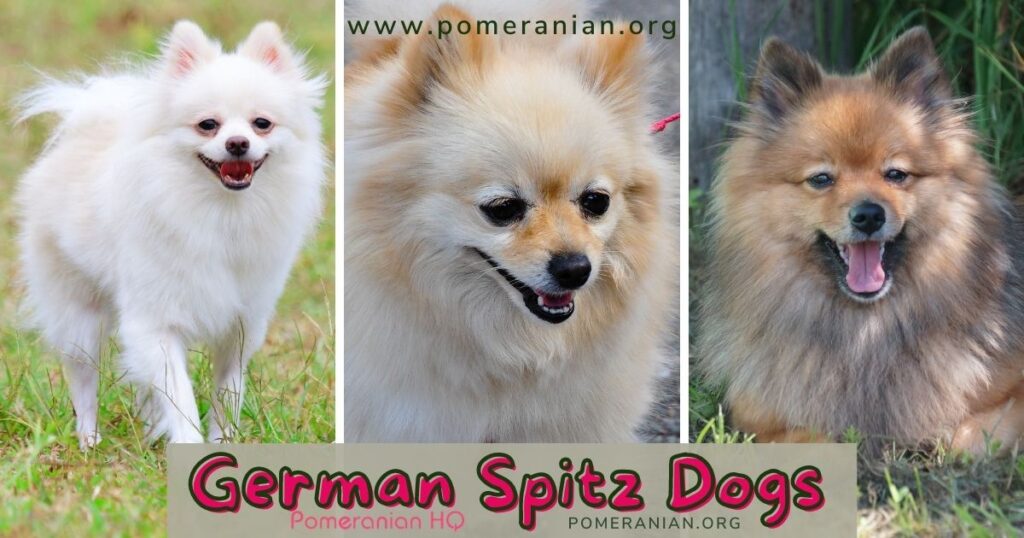
In the USA ( American Kennel Club) and the UK (Kennel Club ), the German Spitz competes in the utility group. In Australia & New Zealand the German Spitz is in the non-sporting group.
• Wolfspitz/Keeshond. 49cm +/- 6cm.
• Giant Spitz. 46cm +/- 4cm.
• Medium size Spitz. 34cm +/- 4cm.
• Miniature Spitz. 26cm +/- 3cm.
• Toy Spitz/Pomeranian. 20cm +/- 2cm.
• Dogs under 18 cm are undesirable.
Each separate variety of the Spitz will have a specific weight that matches its size.
They can be any color or combination of colors and they generally live a long life. As with the Pomeranian, these dogs are generally happy, agile, highly intelligent, and buoyant.
The German Spitz is divided by height:
Klein: 23-29 cms (9-11 5ins) Mittel: 30-38 cms (12-15 ins).
What is the Difference between Pomeranian and German Spitz Dogs?
To understand the difference between both breeds fully, we need to look into the breed history. During the late 1970s, the German Spitz were imported into the U.K. in an attempt to resurrect colors lost to the breed in that country.
Mrs. Averil Cawthera imported Spitz wanting to reintroduce the white Pom (as opposed to the German Spitz). Many imports came from Holland and they included Tum-Tum van het Vlinderhof of Lireva.
The introduction of these dogs into the English Pomeranian world caused considerable angst amongst Pomeranian breeders and exhibitors until, in 1984, the Kennel Club intervened and set up a separate register for the German Spitz.
At the Annual Meeting of the Pomeranian Club in 1978, a motion was moved:
“to note persons placing the Victorian Pomeranians.”
In 1982, a special general meeting of the Pomeranian Club was held in an attempt to resolve the issue of the German Spitz. Prior to the separate register, several of the imports had been bred with Pomeranians and some of the top winning Pomeranians today have German Spitz imports way back in their pedigree.
Many years ago dog fanciers brought varieties of the German Spitz from Germany to the U.S.A. and named them American Eskimos.
The FCI countries include Pomeranians in the group of Spitz dogs as a Toy Spitz/ Pomeranian and the standard states that the height at the withers for Toy Spitz/ Pomeranian needs to be 20 cms +/- 2cm.
Australia, the U.K., the U.S.A., Canada, and numerous other countries place Pom in the toy dog category and he competes in the Toy group.
The Pomeranian breed standards for the U.K., the U.S.A., and Canada state weight requirements instead of height. With the U.S.A. and Canada have the Pomeranian between 3 and 7 lbs and the other countries 4-5 lb. (1.8-2.3 kg).
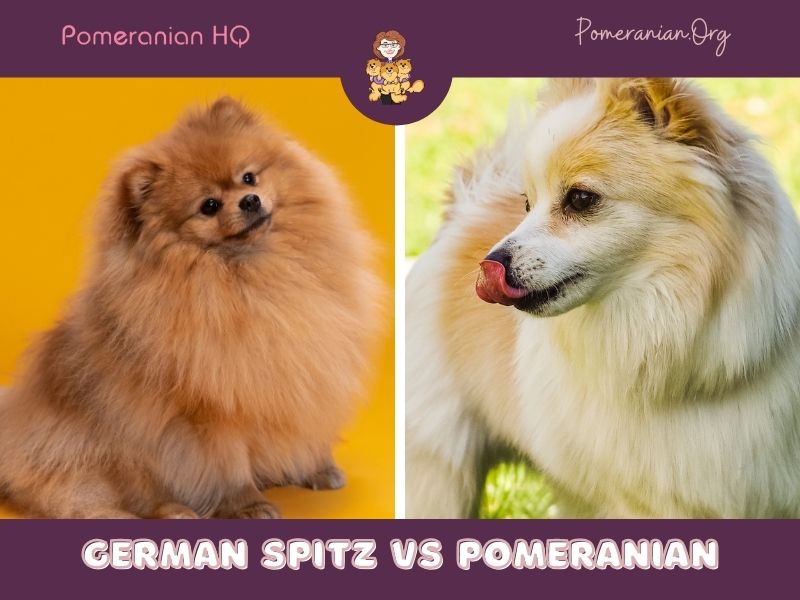
German Spitz vs Pomeranian Differences
The heads of the two breeds vary greatly with the Pomeranian having a shorter muzzle:
The Pomeranian ratio of the length of the muzzle to the skull is 1/3 to 2/3. The small ears are erect and mounted high. The proper set of ears is preferred to the size and ears will often be hidden in the ruff.
In contrast, the head of a German Spitz is flat on top but is shaped like a broad wedge. The muzzle should be roughly half the length of his head so, when compared to a Pom, the muzzle is longer when factoring in the animal’s size.
Their ears should be a triangle in shape and set high on his head. They will always be visible, unlike Poms where ears may be too small to notice if they’re hidden in the Pomeranian’s abundant coat.
The Tail-Sets of the Pomeranian and the German Spitz Differ
The Pom’s heavily-plumed tail lies flat and straight on his back. His buttocks are behind the tail’s set. The German Spitz’s tail curls over the back and is carried to one side or curls into a ring shape.
German Spitz vs Pomeranian Coat
Pomeranian’s Coat:
Abundant outer coat with a short and dense undercoat. This profuse double coat helps to give the impression of a ball-shaped dog.
Forelegs are well-feathered. His hind legs and thighs have a heavy coat that runs to the hock, creating a skirt. You can trim your Pom to ensure he’s neat for the show ring.
German Spitz’s Coat:
When seen in silhouette, the German Spitz doesn’t have enough coat to resemble the Pom.
The breed standard is:
“Abundant around neck and forequarters with a frill of profuse, but not excessive.”
Because the Spitz dogs are usually in bigger proportions, the compact look of the Pomeranian isn’t there. The German Spitz isn’t a breed that needs trimming except for the legs beneath the hocks, the anal area, and the feet. Anything else isn’t acceptable.
Temperament Comparison between the Pomeranian and German Spitz
Even though the two breeds look different, their temperaments are similar. Both breeds are incredibly energetic, always bouncing around, in a lively, long-lasting manner. It’s critical that you keep up with them in some way, whether you’re playing with them, cuddling them, or otherwise entertaining them.
If you need to take time away from them, you must give them things to keep them occupied. While tiny legs may not demand the exercise, it’s almost impossible to calm their brain down enough to rest until they’re completely exhausted.
The two breeds, Pomeranians and the German Spitz are naturally inquisitive and social creatures, keen to make friends with everybody. They also demonstrate a great deal of affection towards their family, loving nothing more than spending a lazy afternoon snoozing in your lap.
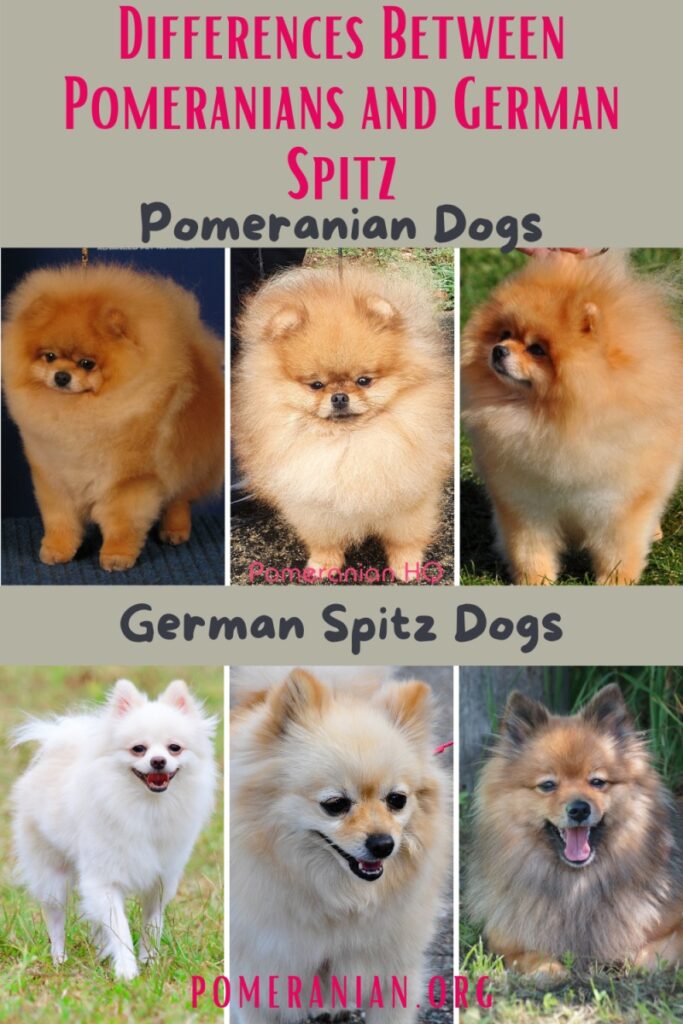
They love being around children but they are both small delicate breeds. It’s vital that you teach them the correct way to manage such a small dog.
Both breeds have a watchdog nature in their past and they’re still naturally yappy dogs. While this might be ideal if you’re after an adorable dog that will always warn you when anything is happening, if you don’t like a lot of barking, or if the neighborhood has noise restrictions, you’ll have to choose a different dog breed.
While both breeds are happy around other dogs, they tend to bark if they’re excited or if they’re challenging other dogs. Because they’re fearless and will bark at much bigger dogs, they often sustain injuries caused by other dogs unfamiliar with their behavior.
Exercise Comparison
The two breeds, Pomeranians and German Spitz dogs are little firecrackers, running around all day. Pomeranians as a much smaller dog require a lot less exercise than the German Spitz.
German Spitz dogs are classed as requiring medium exercise requirements. While the smaller Pomeranian is classed as having low exercise requirements.
Don’t expect either dog to be a lazy lapdog, because they need plenty of exercise or they can become destructive animals if the urge takes over. Each breed needs toys that match their small size.
Training Comparison
As with all dogs, you must socialize these breeds as young as you can. This helps them become comfortable in a range of scenarios. It also means that by the time the dog has become an adult, he’s well-behaved.
Neither breed is shy or timid but if you look at the world from their viewpoint, it must seem bigger and more frightening than it really is. When you socialize a dog, it shapes his demeanor so he transforms into a dog that’s both vivacious and fearless.
While some people see his high-pitched bark as being cute, you must teach him to cease barking on command. Barking can be frustrating sometimes.
Health Comparison
The two breeds, Pomeranians and German Spitz dogs are usually healthy and live long lives. The German Spitz is a fairly new breed in the U.S.A., so there’s only minimal information regarding the health tests that should be carried out.
However, as he tends to have many similar health problems as Pomeranians, it’s logical for the parents to have the same tests such as:
• Eye Exam.
• Cardiac Exam.
• Patella Exam.
Nutrition Comparison
Owing to being a smaller-sized dogs, Pomeranians will generally eat less food than the larger-sized German Spitz.
Grooming Comparison between the Pomeranian and German Spitz
Both breeds require regular coat brushing so their hair doesn’t get tangled. It also aids in the management of fuzzy hair and shedding. If you brush them several times each week, that will suffice.
Another priority is dental care because their jaws are very small. This increases the risk of having problems with their teeth.
The Pomeranian will require more dental attention than his larger cousin, owing to the size of his teeth and jaws.
The Pomeranian requires more grooming owing to his more profuse coat. His coat also needs more extensive trimming for show purposes, whereas the German Spitz requires minimal trimming.
Price Comparison
As the German Spitz is rare in America (American Kennel Club), there’s little demand for them compared to the Pomeranian. Whilst there’s not much information on how much a German Spitz might cost, it seems the cost is around $800+, much less than the cost of a Pomeranian, which is between $1,000 and $5,000.
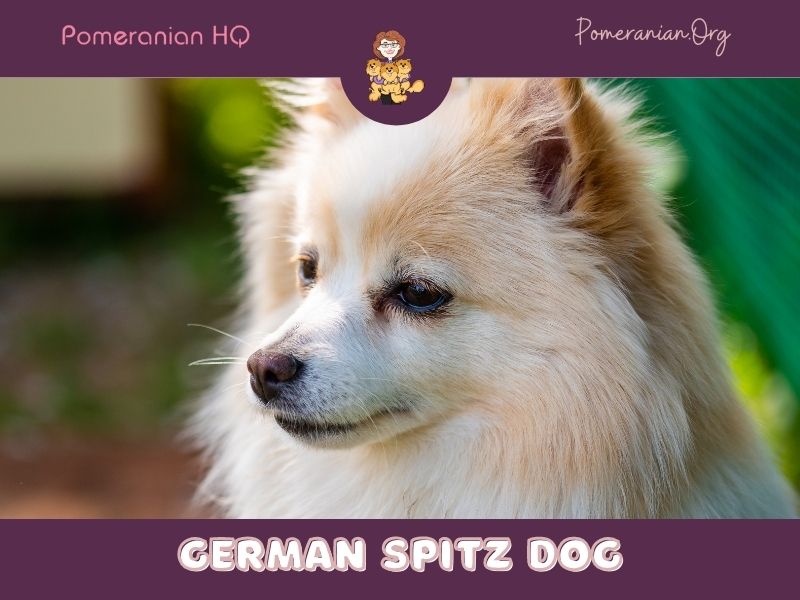
Why do Some “Pomeranians” look more like the German Spitz Dogs?
“Pomeranians” bred by breeders who don’t compete at dog shows will frequently resemble the German Spitz more than the Pomeranian.
This is more often a result of poor breeding practices rather than having a German Spitz in the dog’s pedigree. If you wish the option available is to have the parentage of your dog verified with DNA testing.
Similar can occur in color breeding programs. The Pomeranian breed type often quickly deteriorates and reverts to the German Spitz type.
Coat, size, shortness of back, and pigmentation are usually the first breed qualities to deteriorate with white-to-white Pomeranian breedings.
This syndrome can be called “return to from whence it came” or “drag of the breed” and is evidence of the breed’s origins.
Final Thoughts on the German Spitz vs Pomeranian
The Pomeranian and the German Spitz have a lot in common due to their shared history. The Pomeranian with royal status had its popularity rise to the 23rd most popular dog breed while the other breed has been almost forgotten.
Love is the key to a long healthy, happy life for both people and pets. Owners of either dog breed will make sure that they receive lots of love from their human family.
Pet lovers will enjoy and love their little dog regardless of his ancestry or looks. All dogs give their owners heaps of love and deserve the same in return.
Those Pomeranian owners who feel owning a Pomeranian dog who looks like the famous Boo Pomeranian or having one that looks like a show Pomeranian is important should purchase this toy breed from a show Pomeranian breeder.
Copyright Pomeranian.org. All Rights Reserved.
References and Further Reading:
[1] Official Standard of the Pomeranian (AKC). American Kennel Club, 2011.
[2] Official English Kennel Club Pomeranian Breed Standard, 2017.
[3] Kimbering Pomeranians “1891-1991”.
[4] Denise Leo, The Pomeranian Handbook.
[5] E.Parker, The Popular Pomeranian.
[6] L.Ives, Show Pomeranians.
[7] L.Ziegler Spirer & H.F. Spirer, This is the Pomeranian.
[8] FEDERATION CYNOLOGIQUE INTERNATIONALE (FCI) German Spitz, including Keeshond and Pomeranian Breed Standards. PDF file.


